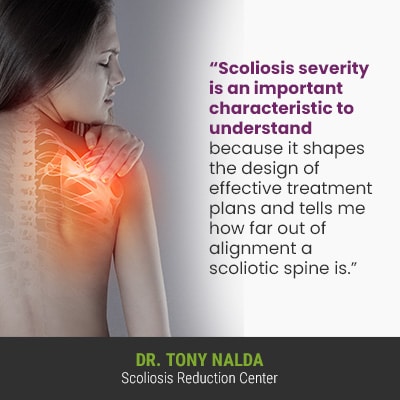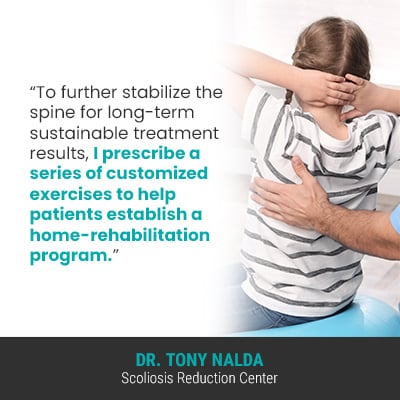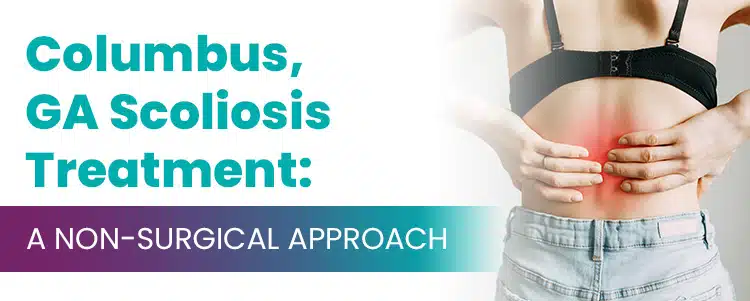As a complex progressive spinal condition, scoliosis requires treatment from a specialist who’s trained and experienced in the many facets of scoliosis treatment. While scoliosis is incurable, it can be highly treatable, particularly when a diagnosis is responded to with proactive conservative treatment.
Those looking for Columbus, Georgia scoliosis treatment should look no further than Dr. Tony Nalda’s successful chiropractic clinic in Celebration, Orlando. A direct two-hour flight can put patients within reach of the Scoliosis Reduction Center®’s impressive treatment results.
It’s important to understand the nature of scoliosis to understand treatment efficacy, so let’s start by exploring some important condition characteristics.
What is Scoliosis?
Being diagnosed with scoliosis means a spinal condition has developed that involves a loss of its healthy curves.
Scoliosis is an unnatural sideways spinal curve, but scoliotic curves don’t just bend unnaturally to the side, they also twist, making scoliosis a complex 3-dimensional condition.
Scoliosis is also progressive, meaning its very nature is to get worse over time, which is why how it’s treated is so important to quality of life.
Scoliosis introduces a lot of uneven forces to the body, and those uneven forces increase as the size of the scoliotic curve increases, as do the effects of those uneven forces.
It’s not just the spine that’s affected, but also its surrounding muscles and nerves, and in addition, as the spine works in tandem with the brain to form the body’s central nervous system (CNS), spinal conditions can cause a wide range of symptoms, particularly those related to nerve compression.
Scoliosis Severity

Scoliosis severity is an important characteristic to understand because it shapes the design of effective treatment plans and tells me how far out of alignment a scoliotic spine is.
Severity is determined by a measurement known as Cobb angle, taken during X-ray, and the higher the Cobb angle, the more severe the condition, and the more likely it is that its effects are going to be noticeable:
- Mild scoliosis: Cobb angle measurement of between 10 and 25 degrees
- Moderate scoliosis: Cobb angle measurement of between 25 and 40 degrees
- Severe scoliosis: Cobb angle measurement of 40+ degrees
- Very-severe scoliosis: Cobb angle measurement of 80+ degrees
Scoliosis Type
In addition to the condition ranging widely in severity, there are also different types a person can develop, based on their underlying cause.
The most common type to affect both adults and children is idiopathic scoliosis, which means not clearly associated with a single-known cause, and the most prevalent form of scoliosis overall is adolescent idiopathic scoliosis, diagnosed between the ages of 10 and 18.
Approximately 80 percent of diagnosed cases are idiopathic, and the remaining 20 percent are associated with known causes: neuromuscular scoliosis, degenerative scoliosis, and congenital scoliosis.
The different types of scoliosis is another reason the customization of treatment is so important, and in addition, patient age and curvature location are additional factors that make no two cases the same.
So now that we’ve explored what it means to be diagnosed with scoliosis, what are some scoliosis treatment options?
Scoliosis Treatment Options: Traditional vs Conservative
As mentioned earlier, there are different ways to treat scoliosis, and it’s important to understand the differences because traditional treatment funnels patients towards spinal fusion surgery, while conservative treatment helps patients avoid invasive surgery.
Traditional Scoliosis Treatment
Traditional scoliosis treatment was the dominant choice for many years, but the reality is that many cases of scoliosis can be treated with non-operative treatment.
Traditional treatment doesn’t have a strategy for treating scoliosis until it becomes severe enough to warrant a surgical recommendation, and this is why it’s commonly described as more reactive than proactive.
Little is done prior to becoming severe to prevent a patient’s scoliosis from progressing; patients with mild scoliosis are commonly told to watch and wait, merely observing whether or not a patient’s scoliosis progresses.
Once a patient crosses the surgical threshold with a curvature degree of 40+, if on the path of traditional treatment, they are commonly presented with spinal fusion as the best treatment option.
While spinal fusion can indeed straighten a scoliotic spine (when successful), it can come at the cost of the spine’s overall health, strength, and function, which can greatly impact quality of life.
For those wanting to forgo a surgical recommendation, or who simply want to try a less-invasive treatment option first, there is a conservative treatment option with impressive results.
Conservative Scoliosis Treatment
Home to Dr. Tony’s Scoliosis Reduction Center®, Celebration, Orlando is only 949 miles, or a 2-hour flight away, and patients can benefit from having access to multiple different forms of scoliosis treatment under one roof.
Conservative scoliosis treatment is proactive, meaning it works towards preventing progression by starting treatment as close to the time of diagnosis as possible.
If I have a patient who is diagnosed with mild scoliosis, this is when I want to start treatment, when the curve is at its smallest, will be its most flexible and responsive to treatment, and before the body has had time to adjust to its presence.
Here at the Center, I want as much of the spine’s natural strength and function as possible preserved, which is why I integrate different forms of treatment into my treatment plans so conditions are impacted on every level.
As a structural condition, scoliosis has to, first and foremost, be impacted on a structural level, and I work towards this through condition-specific chiropractic care.
Through a series of techniques and manual adjustments, I can work towards adjusting the position of the curve’s most-tilted vertebrae back into alignment with the rest of the spine, and this means restoring as much of its healthy curves as possible.
Through condition-specific physical therapy, I can help patients increase their core strength so the muscles that surround the spine can provide it with optimal support.
While no brace on its own can correct a scoliosis, when combined with other forms of corrective treatment, it can help by pushing the spine into a corrective position, and for this, I opt for the modern and ultra-corrective ScoliBrace.

To further stabilize the spine for long-term sustainable treatment results, I prescribe a series of customized exercises to help patients establish a home-rehabilitation program.
When these treatment disciplines are combined, they can complement one another and result in a patient living their best life, despite being diagnosed with a progressive spinal condition.
Conclusion
When it comes to Columbus, GA scoliosis treatment, look no further than Dr. Tony’s treatment center, 949 miles away; he helps patients make sense of a confusing condition so they can thrive.
By combining multiple forms of condition-specific treatment, patients benefit from having their condition impacted on every level for long-term sustainable treatment results.
Although scoliosis is incurable, it is highly treatable, particularly when a diagnosis is responded to with proactive treatment like the type that can be found here, simply by reaching out.




